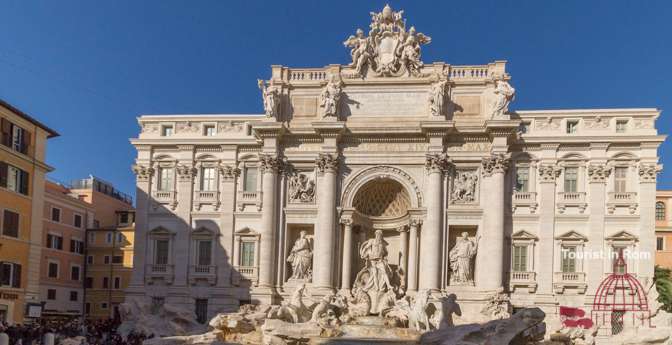The Trevi Fountain, the largest and most imposing fountain in Rome, continues to baffle us even now. A god and a virgin, understand the signs of the Trevi Fountain.
Immerse yourself in the Trevi Fountain’s grandeur and let its magic draw you back to Rome. This colossal spectacle pulsates with the vigor of water that has been transported to the Field of Mars by the millennia-old Virgo Aqueduct. Allow yourself to be captivated by the magnificent theatrical staging of the ocean.
Tips for the visit
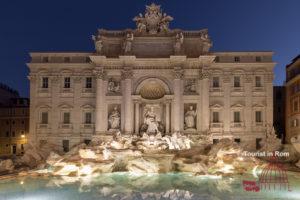
The fountain is freely accessible at all times. However, the steps leading down to the basin are occasionally closed for safety reasons. It’s nice and romantic here with few visitors late at night and early in the morning, between 2 and 7 o’clock. The water is turned off three times a week in the morning to clean the basin, on Monday, Wednesday and Friday.
To take a photo of the fountain, you need a strong wide-angle lens, otherwise it won’t quite fit in the picture. You also have a good view of the fountain from the hotel or the clothing store opposite.
Entering the basin or even stepping into it is strictly prohibited and carries hefty penalties. The water is not suitable for consumption.
Next to the fountain are excavations that delve 9 meters deep, revealing the stratified history spanning over 2,000 years. Among these layers lies a cistern used to supply water to the Field of Mars.
Coins in the Trevi fountain
The most famous practice at the Trevi Fountain is to throw a coin over the shoulder into the fountain. There are no special rules for the coin toss. However, it is important that the coin lands in the fountain to fulfill the wish.
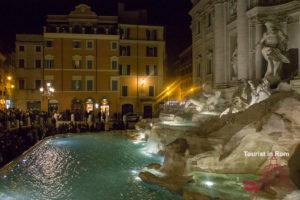
You are doing a good thing! The coins benefit the Roman Caritas, which supports people in need in Rome. With the flip of the coin, you wish to return to Rome. You will see, it works. Its magical! If you throw in several coins, it will bring you luck.
Another old custom concerns lovers. On the right side of the Trevi Fountain you can find the Fountain of Love. Drinking the water will make you stay together forever.
What you see
The fountain is hidden behind small alleyways where you can hear the rushing water. This imposing fountain is the largest fountain in Rome.
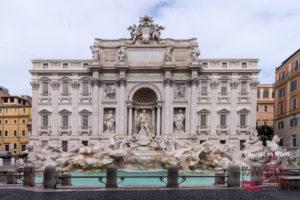
If you stand in front of the fountain, you will see a wide façade. But it does not belong to the fountain, but to the Palazzo Poli behind the fountain. The Count of Poli was not particularly pleased when Pope Clement XII decided to place the fountain in front of it and thus cover part of the palace’s windows. But this makes the fountain look even bigger.
The basin has a width of 49.15 meters, almost Olympic dimensions. The fountain is crowned by the coat of arms of Pope Clement XII, from the Corsini family. The height of the fountain up to the coat of arms is 26 meters.
The representation of the ocean
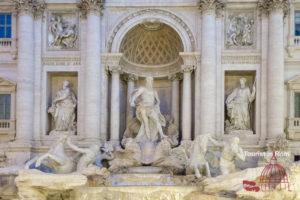
The theme of the fountain is the ocean. In ancient times the ocean was the end of the world but now America had been discovered for almost 150 years and the popes wanted to bring the ocean to Rome.
In the lower part, a rocky coast is depicted with four columns on top. In the niche between the two central columns of the fountain stands the magnificent god Oceanus on a shell. Winged horses pull the shell and are held by tritons. The ocean can be wild or calm, like the two horses. To the left and right of Oceanus are two statues representing abundance and fertility. The reliefs above represent the history of the aqueduct. You can also see various plants such as ivy, oaks, grapes and figs.
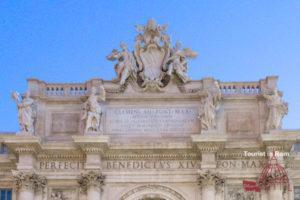
Four Corinthian columns frame the fountain and on them, from left to right, stand figures representing the abundance of fruits, the fertility of the fields, the richness of autumn and the wealth of the gardens. The inscription in the center reports “In the year of our Lord 1735, the sixth of his pontificate, Clement XII adorned with a marvelous work the virgin aqueduct, known for its abundance and health.”
The name Trevi
Ever wondered why it’s called the Trevi Fountain? Well, there are a few ideas about that!
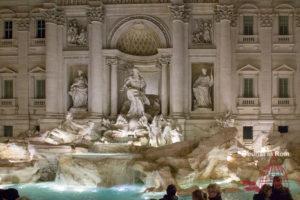
One thought is that in ancient times or the Middle Ages, where three paths met, they called it “Tre Vie” or “Three Roads.” But wait, it can’t be the Via del Corso, which has been running 200 meters to the west for over 2,000 years and was once called Via Lata. The area around it was also known as Via Lata back then.
Another guess is that the place where the water is collected was once called Trebium.
Or maybe, the name comes from the fact that the first fountain had three water basins, just like the one you see today!
Now, here’s a really cool story we like: A long time ago, a virgin named Trivia showed the fountain to a general and builder named Marco Agrippa. As it happens, under the name of Trivia, the Romans prayed to three goddesses, including the lightly dressed Diana, protector of animals, springs and women. The other two were Ecate, responsible for magic, and the goddess Luna.
In the two reliefs above the statues, Agrippa is seen approving the aqueduct project and the virgin Trivia, here demurely dressed, showing the spring to the soldiers. The popes would certainly not have allowed the depiction of an ancient goddess in a breezy minidress.
The aqueduct is called Aqua Virgo, which means “virgin water.” It has been working for more than 2,000 years since it was built in 19 BC. It was made to supply water to Agrippa’s thermal baths on the Martian field. The aqueduct, about 20 km long, mostly runs underground. You can even see part of it in the basement of the noble department store La Rinascente in Via del Tritone. The aqueduct also supplies the Fontana della Barcaccia under the Spanish Steps and the fountains in Piazza Navona.
History of the Trevi fountain
When was the Trevi fountain built? In 1732 Pope Clement XII commissioned Nicola Salvi. Neither Clement nor Salvi got to see the completion of the fountain. Clement died in 1740 and Salvi in 1751. But at least Salvi had two inaugurations, one by Clement XII in 1735 and one by Benedict XIV in 1744. Construction work was interrupted several times, mostly because the fountain was becoming more and more expensive. The fountain was finally completed by Pietro Bracci in 1762. Pope Clement XIII inaugurated it for the third time on May 22, 1762.
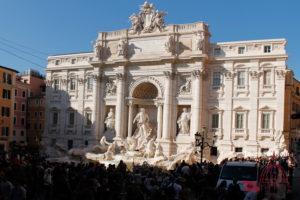
But the fountain has a long history: The aqueduct was inaugurated on June 9, 19 BC by Agrippa and it has been in operation ever since. The first renovation took place under Emperor Constantine in the 4th century. The Goths damaged the aqueduct during the siege in 537, but it remained in operation. Another renovation took place under Pope Hadrian I in the 8th century.
The source of the Aqua Virgo is particularly pure and low in lime. That is the reason why this aqueduct has worked for over 2,000 years.
The aqueduct was used to supply drinking water to the Romans and fed wells at the Pincio, at the Spanish Square and on the Campus Martius. The first Trevi Fountain, with three tubs, is documented in 1410, but there may have been a watering hole here for a long time.
In 1453 Pope Nicholas V had the aqueduct repaired again and had the three tubs replaced by a rectangular tub. After a further renovation by Pope Pius IV, the aqueduct was inaugurated again in August 1570 under the name Acqua Vergine in Piazza di Trevi.
Around 1640 Pope Urban VIII, a Barberini, gave Gian Lorenzo Bernini the order to rebuild the square and the fountain. A wine tax was introduced to finance the project. Bernini had some buildings torn down and gave the square its current shape. However, the money was not enough and the project died in 1644 with the death of Pope Urban. Bernini was commissioned to extend the aqueduct to Piazza Navona. The palace of the new Pope Innocent X, a Pamphili, and the Fountain of the Four Rivers (Fontana dei Quattro Fiumi) built by Bernini are located there.
The last major restoration was carried out by the Fendi fashion house between 2014 and 2015 for 17 months. The inauguration took place on November 3, 2015. In July 2016, Fendi celebrated 90 years with a large fashion show in the Trevi Fountain.
Anita Ekberg and Marcello Mastroianni in the Trevi Fountain
One of the most famous scenes in film history at the Trevi Fountain is how Anita Ekberg lures Marcello Mastroianni into the fountain. See how easily Anita climbs into the fountain and splashes around in the water.
The filming was done in late March 1959 and the water was freezing cold.
It is said that Anita didn’t mind and she could stay in the well for several hours. Marcello, on the other hand, had to put on diving equipment under the suit and drink a bottle of vodka before venturing into the water. He was totally drunk while filming. Although if you look at the film like this, Anita might have lifted a few glasses as well. Na sdorowje!
How to get to the Trevi Fountain
The Trevi Fountain is located on the Mars Field, today’s city center of Rome. The position is somewhat hidden between the Quirinal Hill and Via del Tritone in Piazza di Trevi ![]() .
.
The hop on hop off stop is at Piazza Barberini.
A good orientation gives our description of the city center of Rome.
